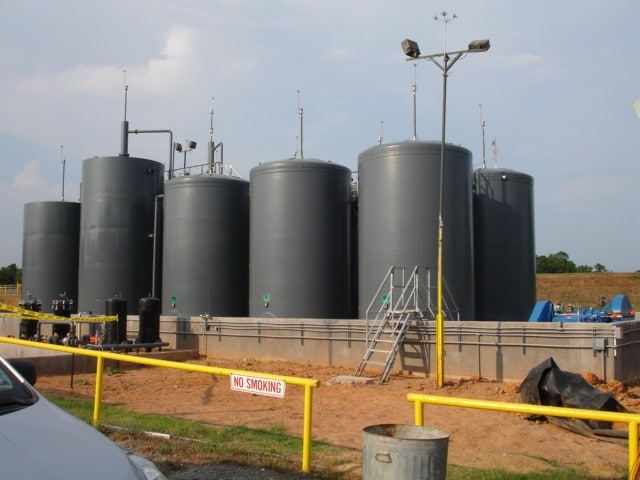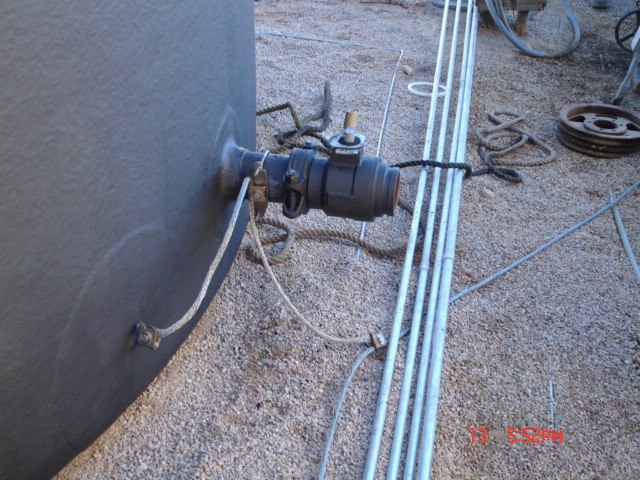Production/Disposal and Storage Tank Grounding
Let’s assume that you have been tasked with designing a lightning protection grounding system for production/disposal or storage tanks. Where do you go for guidance? The two main sources are American Petroleum Institute API recommended practices (RP) 2003 and 545, and National Fire Protection Association standard NFPA 780. (It should be noted that, although it provides lightning protection system design guidance specifically for tanks, the API 545 committee has been disbanded, and the RP rolled into other API documents. However, it remains a useful source of information)
There are two different, and not always convergent, schools of thought that have produced two different standards or recommended practices regarding the grounding of production and storage, and other flat-bottom steel tanks. We will take a look at both approaches.
It should be noted that both standards recommend the minimization of flammable vapors and gases as a primary means of controlling ignition, and caution that grounding for purposes other than lightning protection should be considered.
API
API 2003, September 2015 edition, section 5.4.1, “Inherent Grounding”, states that metallic tanks, equipment, and structures commonly found in the industry that are in direct contact with the ground have proved to be sufficiently well grounded to provide for safe propagation to ground of lightning strokes. It goes on to further state that supplemental grounding by means of driven ground rods neither decreases nor increases the probability of being struck, nor does it reduce the possibility of ignition of the contents. Supplemental grounding is necessary, however, where direct grounding is not provided. Ironically, 2003 then refers the reader to NFPA 780 (see below) for more information on grounding practices for lightning protection. Further, API 545, A.2.2 reaffirms that a tank is considered adequately grounded if the tank bottom is resting on the ground or foundation. A.3 states that the existence or absence of a release prevention barrier is not relevant to the prevention of lightning induced fires or explosions. A release prevention barrier is described as all barriers or combinations thereof that prevent the escape of material or channel released material for leak detection.
Typical production/disposal tank battery

NFPA
NFPA 780, chapter 7 addresses “Protection for Structures Containing Flammable Vapors, Flammable Gases, or Liquids That Can Give Off Flammable Gases”. Although API specifically addresses tanks, NFPA also includes other types of structures. It is important to keep that in mind when applying chapter 7 to tanks. Also be aware that the chapter specifically excludes non-metallic (fiberglass) tanks.
NFPA 780, 7.3.7. addresses grounding of all structures containing flammable vapors, flammable gasses, or liquids that can give off flammable vapors. 7.3.7.1 requires a ground ring electrode or ground loop conductor supplemented by grounding electrodes for such structures. 7.3.7.2 exempts structures with a perimeter projection of 200 feet or less. 7.3.7.3 specifically addresses metal tank and requires grounding by one or more of these methods: (1) connection without insulating joints to a grounded metallic piping system, (2) accepting inherent self-grounding of vertical cylindrical tanks greater than 20 feet in diameter resting on earth or concrete or greater than 50 feet in diameter resting on bituminous pavement, (3) a minimum of two grounding electrodes at intervals not exceeding 100 feet around its perimeter. If the tank is installed over an insulating membrane for environmental or other reasons, either (1) or (3) is required (self-grounding over a containment barrier is not recognized).
Supplemental grounding

DISCUSSION
As you can see, there is quite a gulf between API and NFPA requirements. This may be explained by looking at the history of document development and the backgrounds of the writing committee members.
The API committee members tended to come from the owner/operators, with years of practical field experience designing, building, operating and maintaining these facilities. The NFPA committee members, while very experienced in lightning protection for ordinary facilities, have little or no experience with these types of structures. Indeed, most have not been on, or even near, a storage or production facility.
INHERENT SELF-GROOUNDING OF FLAT BOTTOM STEEL TANKS
Inherent self-grounding of flat-bottom steel tanks has always been part of the API lightning protection documents, and is part of the NFPA 780 document, albeit with minimum diameter requirements. Acceptance of this method of tank grounding is particularly important to production/disposal tank operators, as these tanks generally do not meet the minimum diameter requirements of NFPA 780. Why the minimum diameter requirements? There are tens of thousands of these tanks out there that have been safely and happily self-grounding for millions of tank years.
The 20 foot (resting on earth or concrete) and 50 foot (resting on bitumen) requirement contained in NFPA 780, 7.3.7.3 appear to have been introduced into the 1983 edition by tank owner/operators. However, no justification for these minimum diameter requirements could be found. If owner/operators wanted to introduce a minimum diameter requirement, why was only NFPA changed and not the applicable API documents? Indeed, I remember discussions at an API 545 committee meeting (in New Orleans, I believe) on this very subject where it was agreed not to change grounding requirements in any way, including not introducing a minimum diameter requirement.
We continuously run into petroleum engineers that point this out when the subject of using 780 as their standard arises. They look at the NFPA 780 minimum diameter requirements versus years of successful field experience with inherent self-grounding of smaller diameter tanks and conclude that 780 simply does not understand the nature of tanks. They also are happy to point out that the NFPA 780 grounding requirements look suspiciously similar and are more appropriate to the requirements for grounding a small, round wood barn as opposed to grounding a heavy, flat-bottom, thick wall metal structure sitting on earth. They are also quick to ask why a 4 sq ft grounding plate installed at minimum depth is adequate for grounding but not a 100+ sq ft tank bottom.
When the only solution you have is a hammer, every problem looks like a nail. NFPA 780 systems are direct descendants from those designed by Ben Franklin to keep wood structures, particularly barns and houses from burning down. This ignores the fact that a metal tank is wildly different from a wood barn.
A useful exercise in understanding inherent grounding of flat bottom metal tanks is to consider grounding of a non-metallic structure similar in size and configuration to a tank. If we look at a structure such as a 14’ diameter round wood barn, according to NFPA 780, structural lightning protection would be installed in the form of lightning rods bonded together by a main conductor, and at least two down conductors. The down conductors could be grounded by flat metal plates, each a minimum thickness of 0.032” with a minimum surface area of 2 ft2 if buried greater than 18” below grade (NFPA 780, 4.13.5.1). If installed at a depth of less than 18”, the surface area of the ground plate must be increased to 4 ft2 (Underwriters Laboratories installation guideline UL 96A). This design would require that, in the event of a direct attachment to the structure, all of the lightning energy travel down two down conductors of extremely limited cross section and be dissipated to earth through two ground plates of limited size. On the other hand, a direct lightning attachment to a 14’ diameter metal tank would allow the lightning energy to flow down the much larger surface area of the tank shell and be dissipated to earth over the much larger surface area (615 sq ft) of the tank bottom. The short duration, high energy portion of the strike would tend to be dissipated to ground around the perimeter of the tank bottom (analogous to shunts on an external floating roof (EFR) tank), with the longer duration, lower energy portion of the strike spreading across the tank bottom (analogous to bypass conductors on an EFR tank). That is why flat bottom metal tanks are considered to be inherently self-grounding. It is much larger in surface area that a flat grounding plate and is pressed downward on the earth with thousands of pounds of weight of the tank and the stored product.
NFPA 780, Annex B.4.3, states that properly made ground connections are essential to the effective functioning of a lightning protection system, and every effort should be made to provide ample contact with the earth. This does not necessarily mean that the resistance of the ground connection should be low, but rather that the distribution of metal in the earth or upon its surface in extreme cases should be such as to permit the dissipation of a stroke of lightning without damage.
Many newer production/disposal sites are surrounded by metal wall containment systems. These systems constitute an attractive solution in that they may become part of the site bonding/grounding system. If they form continuous steel wall around the site and otherwise meet the requirements of NFPA 780 they may be used as a conductor/grounding system.
SUMMARY
Two different results deriving from two different approach to grounding are presented above. Which one to employ? Basically, it is up to your judgement
The API documents were written to specifically address tanks, whereas NFPA 780 was written to address a variety of structures. Therefore, API appears to be the go-to document for tank grounding. However, NFPA 780 offers much more detail covering the design of structural lightning protection, so a combination of both documents may be in order.

